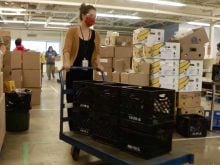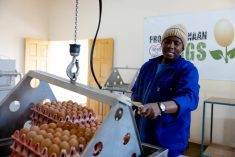A fall in grain prices has led to the impression that food security is no longer a concern, but the number of people without enough to eat is still rising in a world facing recession, the United Nations said March 31.
“The level of prices is still 19 per cent above the average of 2006 … so we’re still in a period of high prices,” Jacques Diouf, director general of the UN’s Food and Agricultural Organization (FAO), told reporters at a conference in Bangkok.
In addition, recent FAO studies showed that even though prices had fallen in international markets, retail prices in most developing countries had not.
Read Also

Local farm businesses, groups look forward to Manitoba Ag Days 2026
Most of agriculture is seemingly at Manitoba Ag Days each January: Manitoba agribusinesses and farm groups look forward to connecting with farmers at the 2026 show.
“Not only is the crisis here, but it’s been worsened by the financial and economic crisis,” Diouf said.
Stocks for cereals were at a 30-year low, and he described the situation as “very fragile.”
“We’re afraid that if there are any serious climate factors affecting production, we will be back to where we were in 2007. We’ve seen serious floods in North America and southern Africa,” he said.
The FAO estimates that over one billion people in the world will go hungry this year because of the combined effects of the global economic crisis and high food prices.
The number of chronically hungry people has been rising steadily – by 75 million in 2007 and an estimated 40 million in 2008. By the end of 2008, 963 million people were undernourished, almost two-thirds of them in the Asia-Pacific region.
Diouf said aid needed to be directed back to agriculture.
“The first and foremost important element is the need to invest in agricultural production (to combat hunger), and this would require $30 billion a year,” he said.
That sum, enough to help around 500 million small farmers, would have been considered high in the past, but he put it in the context of the trillions of dollars that western governments had poured into schemes to stimulate their economies.
Between 2006 and 2008, the FAO says, fertilizer prices rose 170 per cent and seeds and animal feed by at least 70 per cent, putting them out of the reach of small farmers.
Diouf said aid donors needed to ensure agricultural funding went back to the levels of the late 1970s and early 1980s, when 17 per cent of overseas development aid went to agriculture, facilitating a “green revolution” in Asia and Latin America.
By this decade, that share had dived to a mere three per cent.














